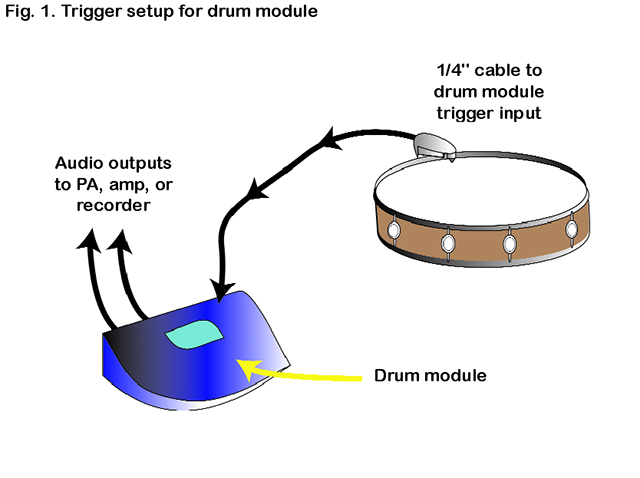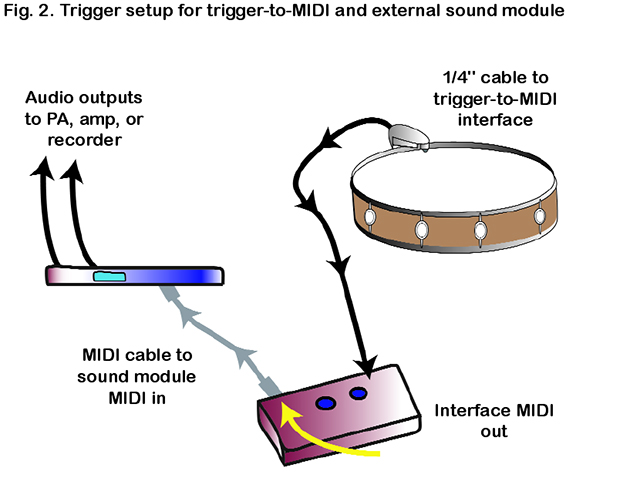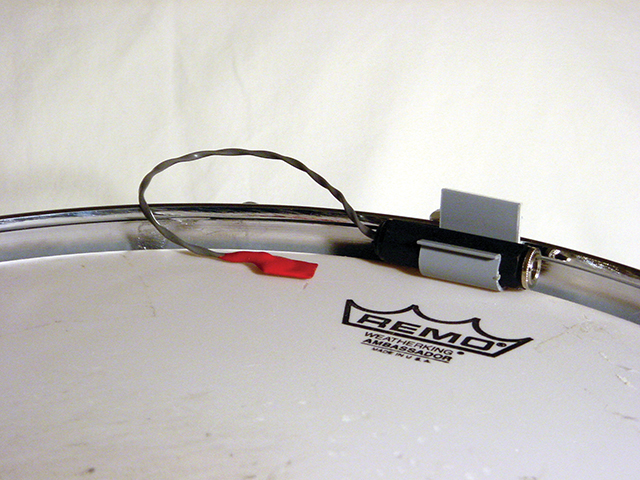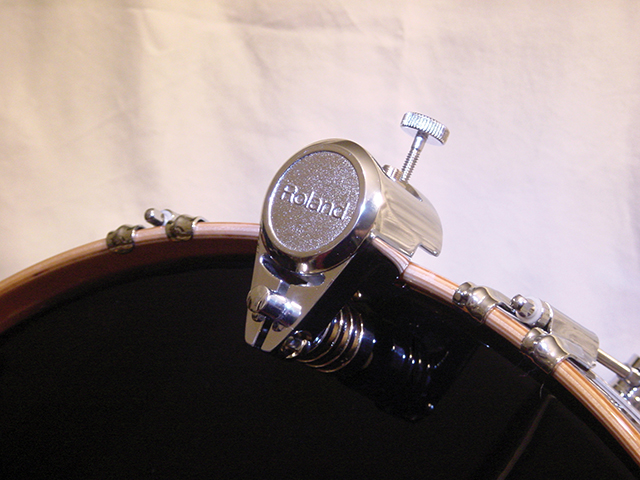BY MIKE SNYDER
Drummers have triggered electronics from acoustic drums for more than 20 years (yes, we did have running water and electricity back then, too), but triggering hardware and software has recently improved tremendously, which might explain the renewed interest in acoustic drum triggers. With that said, let’s all spit out our gum and take a class in triggering 101.
The concept of triggering acoustic drums is actually quite simple. When using drum triggers on your acoustic drums, the drum trigger/acoustic drum combination takes the place of the electronic drum pad.
Some of you are probably saying to yourself, “Okay, but I’m an acoustic guy who breaks out in a rash when I plug in the vacuum cleaner. Exactly how do I do I trigger my drums, what gear do I need, and how do I benefit from triggering?” It just so happens that you’ve stumbled onto the right article.
All You Wanted To Know About Drum Triggers
CLUBBING, SEVEN IRON PLEASE
Drum triggering makes a lot of sense for club work. Every room sounds different, the quality of the PA is all over the map, the quality and quantity of the microphones are often unsatisfactory, and the sound person … well, let’s just leave that for a later discussion. Point being, unlike bass and guitar players, we have little control over how our instrument sounds to the audience.
Triggering a great sounding drum module from our drums solves much of this problem. Think about it, the drum triggers plug into the sound module, a 1/4″ cord goes to the PA or our personal drum amp, and out comes crushing, studio quality drum sounds. We can even change drum sounds to match the style of each song!
Since there are fewer open mikes on the drums, that loud guitar player won’t bleed into your mikes. This makes for clearer, punchier, and louder drums in the PA, without other instruments mucking things up. Taken one step further, with the possible exception of overheads, if we bring our personal drum amp, we can bypass front-of-house sound altogether. Killing five-minute drum sounds with almost no mikes? Now, that’s living large.
Recording, or “Where’s the MIDI jack on your snare?” Recording hardware and software has changed so dramatically that a great deal of work is now done in small production studios, and many just weren’t designed to handle an acoustic drum set. By triggering drums, though, we can play our acoustic set, record the overheads (cymbal mikes), and record our “drum performance” as both MIDI and audio coming from the drum sound module.
The advantage of this is if any of the drum sounds need to be changed, we don’t have to come back and rerecord our part. The engineer just dials in another snare, kick, or tom sound.
This setup is also commonly used in larger “acoustic drum friendly” studios. The main difference is that in addition to the MIDI performance, triggered drum sound, and overhead mikes, the entire acoustic drum sound is also recorded. This gives the producer an amazing amount of sonic material to choose from at mix-down. You might be surprised how many drum tracks consists of an acoustic sound beefed up by a triggered sound, or even completely replaced by it.

THE SETUP – PARTS IS PARTS
There are a myriad of different options for both drum triggers and trigger interfaces/sound modules, but have no fear – Trigger Man is here to save the day. Well, if not save the day, at least to help you more clearly understand what’s needed to trigger drums.
Take a look at Fig. 1. This is the most basic trigger setup. It contains three items: the drum, the trigger mounted on the drum, and the trigger interface. There are two different types of trigger interface, those that have sounds on board (often referred to as “drum modules”) and those without sounds (often referred to as “trigger-to-MIDI” converters).
They both do the same thing – turn a trigger pulse into MIDI. The choice of which one to use depends on your situation. Fig. 2 shows the setup for a trigger-to-MIDI converter and an external sound module.
If you already have an electronic drum set, chances are that you have a drum module that will function as a trigger interface. These could be older drum modules like the Roland TD-5 and Alesis D4 or DM5, or newer drum modules like the Roland TD-6, TD-8, and TD-10, or the Yamaha DTXtreme. If you already have a drum module, you have the most expensive part of a drum trigger setup. How cool is that? But, for those of you who don’t, let’s look at what is available.
If you don’t have any kind of trigger-to-MIDI interface or drum module, I would suggest getting a drum module. It not only acts as the trigger-to-MIDI interface, but also contains the sounds you’ll trigger. There are many drum modules out there, both new and used, at all price levels.
But I always look for the best bang for the buck. So, there are two on the less expensive side that I’d recommend, one that can be found on the used market, and another that’s probably only available as a new item.

As far as used gear goes, look for an Alesis D4, D-5 or DM-Pro. They’re easily found in the $100 to $200 range. I used a D-4 in the late ’80s/early ’90s as part of my studio rig, and it performed adequately, although you do give up some features for the low price. First, the drum sounds are, well, about 15 years old. Back when it was designed, memory and processing power was expensive, so some sounds don’t have the longest ring out, especially cymbals and toms.
Some might argue that they are a bit dated, but hey, that can be a good thing. The first thing you’ll notice is that trigger response time is long. That is to say, the time between when the drum is hit until the audio comes out is very noticeable. The amount of delay is in the range of what we use to layback or get on top of the beat, so the delay can be a little disconcerting.
This delay is most notice-able on the kick drum. Because of the sharp attack of the kick, when you put the acoustic kick together with the triggered sound you will hear some flamming. But, for the price, it will get you started in the world of drum triggering.
If you have a few more dead presidents that you want to put back into the economy, I’d highly recommend buying a Roland TD-6 drum module. It has massive bang for the buck. First, it’s one the newest drum modules on the market, and one of the least expensive. It has more than 1,200 sounds and real fast trigger response. There is no flamming on the kick drum like with the Alesis module. I’ve seen it in the stores for around the $500 range.
If you already have an external sound module, you just need a trigger-to-MIDI interface, and there are a couple of good ones out there. On the used side, look for a midiKITI by KAT. It may a bit hard to find, but the search is well worth it.
Because it is a solely a trigger-to-MIDI interface it doesn’t have any sounds on board, and will have to be connected to an external sound module with a MIDI cord. The midiKITI’s user interface is a bit cryptic, but its advanced software settings handle triggering from acoustic drums very well. A good buy if you can find one used.
If you want to stop by your local store and buy a new trigger-to-MIDI converter, get Roland’s TMC-6. It’s about the size of a paperback book and the interface couldn’t be more user friendly. The triggering is derivative of the TD-Series drum modules, therefore very quick and sophisticated.
It sells for around $250, and can be found readily at your local music store. As an aside, the TMC-6 can be used to expand the number of inputs on your existing drum module – just connect the MIDI out of the TMC-6 to the MIDI-In on the drum module.
LET’S GET TRIGGER HAPPY!
Triggers sense vibration from one of three places: directly from the head, from the rim, or from the drum shell. Beyond that, there are two basic trigger construction types, those that stick to the head or shell with an adhesive (“head contact triggers”), and those that use some sort of housing to mount to the rim and then press the trigger assembly against the head (“rim mount triggers”).
All of these triggers use piezo crystal technology. Piezo technology isn’t some big mystery – we have piezo crystals all around us daily. Any piece of electronics that beeps, like a microwave, is probably using a piezo crystal as a speaker. When a piezo crystal has voltage applied to it, it vibrates, creating the beep sound. In drum trigger land, the crystal is used in the opposite direction.
When we hit the drum, the head (or shell) motion vibrates the piezo, which creates a small amount of voltage that is sent to the trigger-to-MIDI converter. The trigger interface turns this voltage spike into MIDI information (note number, velocity, MIDI channel, etc.), and the MIDI information is sent to make the sound source play a sound.

Fig. 3. Generic head contract trigger
There are many drum trigger manufacturers, and most sell head contact triggers (see Fig. 3). These are the generally the least expensive drum triggers, but also the most fragile. Since they permanently mount to the head with adhesive or double-stick tape, they usually stay on the drum all the time.
As you can see, the sensor, exposed wire, and jack arrangement leaves it open to damage, most often pinching the wire where it passes over the rim. Don’t get me wrong, many professional drummers use this kind of trigger. They work great, but you have to take care of them.
Another trigger arrangement is the rim-mount trigger. The major players are ddrum, Roland, and Trigger Perfect. The ddrum rim mount trigger has been around longest. This trigger works very well, although it doesn’t have any sensor height adjustment to compensate for varying rim heights.
Depending on the drum rim it mounts to, it may not even reach the head if the rim is very high, or in the case of low rims, may muffle the drum by pressing down on the head a little too much. This trigger also requires a XLR-to-1/4″ cable to connect to the drum module, a cable you’ll be hard pressed to replace right before your 9:00 p.m. start time. That being said, all in all this is a good trigger.
I must put a disclaimer here. The next trigger is from Trigger Perfect, a company that I started in 1987 and sold a number of years ago. I designed and hold a patent on their rim mount trigger, but I’m doing everything to be objective. Honestly, I am.
Trigger Perfect’s rim-mount trigger offers performance similar to ddrum and Roland triggers. It also mounts on the rim, but has a number of improvements over the ddrum. Most notable is the trigger element height adjustment. This adjustment allows the trigger element to be pressed against the head no matter what the rim height is.
There is also very little of the sur-face area of the sensor (trigger element) actually touching the head, thereby eliminating nearly all muffling of the drum. Like most other drum triggers it uses a standard guitar cable (1/4″-to-1/4″) to connect to the drum module or trigger-to-MIDI interface.

Fig. 4. Roland RT-7K kick trigger
The last rim trigger is the newest (see Fig. 4). Roland’s RT-Series drum triggers draw design elements from all the triggers that have come before them. Not only do they have adjustable sensor elements (kick and snare), Roland has also cleverly applied the sensor design of the mesh headed V-Drum pads to the kick and snare trigger.
The inverted cone trigger element assembly doesn’t muffle the head, and it also helps dampen false and double triggers. It’s important to note that the RT-3T tom trigger doesn’t even touch the head, it senses the head vibration through the rim, so we can have tom ring for days.
SETTING THE SOUND MODULE’S PARAMETERS – HEY WHERE’S MY CHICKEN?
Practical application of triggering technology can at times be challenging, sort of like herding cats, but through patience and experimentation it can be harnessed with great success. You have to remember that every drum is different, and because of that there isn’t just one set of software settings that will work on every drum.
So let’s take a look at what each of the most common trigger settings (parameters) actually do. Each manufacturer may call the same function by a different name, but like parameters, no matter what they’re named, will function similarly. Be sure to read the owner’s manual for your interface or drum module. Also familiarize yourself with your drum module’s user interface. Yes, you should actually read the manual.
Before any other parameter is set on the trigger interface, check to see if you can select the “trigger type” on your drum module or interface. While older modules may not have this parameter, most newer ones do. This will set the trigger settings in the ballpark of where they need to be.
Next the “sensitivity” level or “gain” must be set to match your playing style. Keep in mind, when you set trigger parameters by yourself, there’s a tendency to play softer than you do in actual performance. So smack them! When you play your hardest, the sensitivity graph should peak out. Don’t set the sensitivity too high, otherwise it’ll limit your dynamic range, and can lead to problems like double triggering and notes dropping out. Don’t worry if the triggering isn’t very good at this point, we’ll make it better.
“Threshold” is next. I set this by setting the threshold parameter to “0” – its most sensitive. I then play the drum at the lowest volume I plan to play, and raise the threshold until the triggered sound begins to occasionally drop out. I then lower the threshold a number or two. Take note – the tendency is to play the drum softer than you will in performance. Be realistic with your expectations. If you play loud, the drum doesn’t have to trigger very quiet sounds.
One of the most important parameters is “mask time.” This setting is definitely called by various names, so check the manual for what it’s called on your interface. “Mask time” is the parameter that is most responsible for getting rid of double, multiple, and false triggers. If possible, find out how your interface’s numeric values correspond to actual milliseconds. It will make the process of setting this parameter a bit clearer. If not, you’ll just have to rely on you ear a bit more.
Take the “mask time” parameter all the way down to “0,” then play the drum as fast as you will in actual performance. Raise the threshold setting until the double triggering is reduced or gone, then continue to increase the value until some notes don’t trigger. Then back the setting down a few notches. Repeat this process for each drum.
For reference, the space between notes in a buzz or orchestral roll is around 15ms. The space between flams played by a double pedal on a kick drum is around 50ms. As a rough rule of thumb, the snare will have the smallest mask time, the toms will have mask times that increase as the toms get lower in pitch, and the kick will have the largest mask time.
There are other parameters that are specific to each different trigger interface. A few of them are “retrigger cancel” on the Roland interfaces and “velocity curve” on both Roland and Kat interfaces. I’m sure there are others, so crack the manual.
Trigger Wisdom & Conclusion
It’s very possible that after following the previous directions, you may still encounter either note dropouts or double triggering. Such is life in triggering land. Here’s where you must snatch the rock from my hand, Grasshopper. All I can suggest is that you play with the mask time, threshold, and sensitivity.
It’s a balancing act. There are no hard and fast rules at this point, you must experiment and tweak. You may even find that other “trigger type” settings work even better than the “acoustic trigger” setting.
If all else fails you can muffle the snare and toms a bit. I often use a third of a muffle ring on the snare drum and a small loop of duct tape on the batter head of the toms. I’ve even seen people trigger drums that are filled with packing peanuts so that the drums make no acoustic sound at all. The more muffled the drum, the easier it is to trigger.
Well, I hope this gives you some insight into the scary and mystical world of drum triggering. Dive in and experiment – it’s extremely hard to make smoke come out of a drum module or trigger-to-MIDI interface by just pushing buttons. You need a cup coffee to do that!
TRIGGERING TERMINOLOGY
A To Z (well at least to W)
Amplitude. The height of the waveform, measured in volts.
Crosstalk. The vibration of the drum or pad being struck to cause another drum trigger or pad to fire. Usually caused by sympathetic vibrations.
Double Trigger. One or more sounds sounding after the initial intended pad or trigger hit.
Mask Time. The amount of time a trigger input waits before it will react to another trigger waveform. Generally measured in milliseconds.
Milliseconds. A measurement of time. One-second equals 1,000 milliseconds (ms). In-air sound travels at the rate of about one foot per millisecond.
Sensitivity. A trigger interface setting used to balance out the varying voltage output levels of different acoustic triggers or pads and playing styles.
Scan Time. The amount of time after receiving a trigger signal that a sound module takes before reading the waveform amplitude to determine the volume (velocity) of a sound. Measured in milliseconds.
Threshold. The point below which a trigger waveform will not be recognized.
Velocity Curve. A trigger interface setting used to alter how a sound module’s sound output volume changes in relation to user input.
Waveform. The representation of the voltage output of a drum trigger. Shown in amplitude over time.
